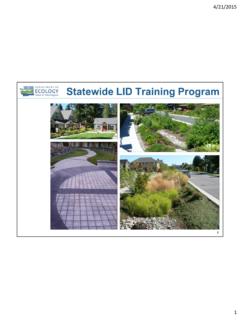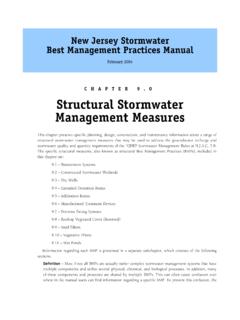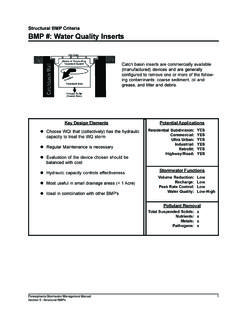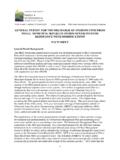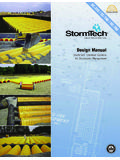Transcription of Public Private Partnerships for Environmental Facilities ...
1 April 2015. Table of Contents Section Page Foreword .. v Executive Summary ..viii I. Introduction .. 1. Urbanization and the Role of Green Infrastructure .. 1. The Need for New stormwater Solutions .. 7. Environmental Regulatory Drivers .. 8. Traditional stormwater Program Approaches Cannot Meet Community Needs .. 10. Potential Economic and Water Quality Benefits of Green Infrastructure and Innovative Designs and Technologies .. 10. Advantages to Public Agencies Entering Into CBP3s for Green Infrastructure Retrofits 11. II. Traditional P3s in the and Their Use in the Water Sector .. 12. P3 Contract Structure .. 12. Traditional P3s and the Water Sector.
2 12. Value and Risk Assessment .. 13. Federal, State, and Local Regulatory Policies Supporting P3s .. 14. Transportation, Water Sector, and Energy P3s .. 19. P3 Investments .. 21. III. Comparing a CBP3 for Urban Retrofits to a Traditional P3 .. 22. Evolution of the CBP3 Model and Use to Address Urban retrofit Challenges .. 22. A Model for the CBP3 .. 24. CBP3s Support an Affordable Green Infrastructure retrofit Approach .. 25. Benefits and Potential Cost Savings of CBP3s for Green Infrastructure stormwater Retrofits .. 25. Key Components of the 28. CBP3 GI retrofit Alternative Financing Model Works to Utilize Drivers and Overcome Barriers.
3 29. IV. CBP3 Highlights for Municipal Leaders .. 31. Key Considerations .. 31. Potential CBP3 Pitfalls and Limitations .. 35. V. CBP3 Highlights for Financing Officials and Advisors .. 37. Finance Strategy & Approach .. 37. Financially Structuring a Long-Term Government Partnership .. 39. ii April 2015. Relative Cost of Financing .. 41. Collaboration with a Private Partner to Establish the Right Financing Structure .. 43. Risks and Benefits of the CBP3 Structure .. 44. Advantages of this Finance Strategy to a Government Entity .. 44. Program Reserves that Create Surety of Execution .. 47. VI. Determining if a CBP3 is Appropriate.
4 49. Implementation Challenges and Barriers for Local Governments .. 49. CBP3 Community Considerations .. 50. P3 Legislative Climate in the Chesapeake Bay- Mid-Atlantic Region .. 52. VII. Partnership Checklist .. 59. Sustainable and Predictable Revenue 59. Measurement and Verification .. 59. Other Community 59. Jobs .. 60. Outreach .. 60. stormwater and Local Building Permit Programs .. 60. Procurement and Contract Process .. 60. Policy and Regulations .. 61. VIII. Establishing the Steps for Developing a CBP3 .. 62. Key Activities .. 62. IX. Potential Business Structures for GI-Driven stormwater Management CBP3s .. 64. Partnership Model Using an 65.
5 CBP3 with Municipality in a LLC/Partnership .. 66. CBP3 Purely Private LLC in Contractual Arrangement with Municipality .. 68. Municipality Borrowing Public Capital and Contracting .. 69. X. Examples of GI-Driven P3 Approaches in the Mid-Atlantic .. 71. The Clean Water Partnership - Prince George's County GI stormwater retrofit Model: An Affordable Alternative to Finance, Construct and Maintain Water Quality Infrastructure 71. Introduction .. 71. Driver/Need for a New Business Model .. 71. EPA's National Interest in a New retrofit Business Model .. 72. Public Private Partnerships in 72. Best Fit P3 Model for Urban retrofit .
6 73. P3 Benefits and Advantages .. 74. P3 Program Unique Features .. 77. Lessons Learned .. 78. Philadelphia's Greened Acre retrofit Program (GARP) .. 79. Incentivizing Green Infrastructure Retrofits with Trading in the District of Columbia .. 80. iii April 2015. XI. Use of Alternative Market-Based 83. GI Implementation at the Operational Level .. 83. Roles at the Operational Level .. 83. Turn-key Service Providers .. 84. Market-Based Tools and Private Properties .. 85. XII. Potential Financing and CBP3 Implementation Scenarios for EPA Region 3.. 88. Public - Private Partnerships and the Impact on stormwater Financing .. 88.
7 Scenario 1: General Fund Financing .. 89. Scenario 2: stormwater Utilities .. 90. Creating Program Efficiencies and Financing Innovation: State Revolving Funds and Grant Programs .. 94. Scenario 3: Leveraging Private Investment through the SRF Program .. 94. Scenario 4: Establishing P3s through Targeted Grant Programs .. 95. CBP3 Hypothetical Scenarios for Mid-Atlantic 98. Scenario 1: Dedicated stormwater Fee .. 99. Scenario 2: VA Phase I MS4 No Dedicated stormwater Utility Fee .. 100. Scenario 3: PA Phase II MS4s Regional Approach .. 101. Scenario 4: DC Phase I MS4 and stormwater Retention Credit Trading Program .. 102. Scenario 5: DE Phase I or II PACE or SRF Leveraging.
8 102. Scenario 6: Philadelphia, PA Grant Funding Leveraging .. 103. 105. iv April 2015. Foreword The purpose of the Clean Water Act (CWA) is to restore and maintain the chemical, biological, and physical integrity of the nation's waters. Passage of this legislation over 40 years ago led to unprecedented efforts to clean up waters in order to render them fishable and swimmable. These efforts, largely driven by funding from the federal government, have resulted in substantial reductions in the discharge of pollutants from point sources and yielded significant improvements in water quality throughout the country. These water quality improvements allowed recovery of aquatic ecosystems and greater Public uses of the resources.
9 While most of the traditional point sources have been reasonably addressed, further improvements will require addressing non-traditional point sources and non-point sources of pollution ( stormwater ) one of the leading causes of water quality impairment and diminished watershed health. Both of these pollutant sources will have much greater social and economic consequences than we have faced in the past. In addition, many of the engineering fixes which controlled point- source pollution are now reaching the end of their useful life. This will require even greater financial resources than those committed during the first four decades of the CWA.
10 Pollution associated with stormwater runoff has increased in many watersheds across the country, including the Chesapeake Bay watershed. It represents the major challenge to this country's water quality in the twenty-first century. According to EPA's National Water Quality Inventory: Report to Congress ( EPA, 2010a), nonpoint source pollution from agriculture and urban runoff is the primary reason that more than 40 percent of surveyed rivers, lakes, and estuaries are not clean enough to meet basic uses such as fishing or swimming. While agricultural pollution is of significant concern, stormwater runoff is the fastest growing source of pollution to the Chesapeake Bay.

